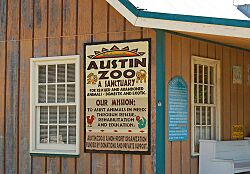Austin Zoo facts for kids

Zoo entrance
|
|
| Date opened | 1990 (as Good Day Ranch) |
|---|---|
| Location | 10808 Rawhide Trail Austin, Texas, U.S. |
| Land area | 16 acres (6.5 ha) |
| Coordinates | 30°15′25″N 97°56′09″W / 30.256876°N 97.935761°W |
| No. of animals | 300 |
| No. of species | 100 |
| Annual visitors | 232,000 |
| Memberships | ZAA |
The Austin Zoo is a special place located near Austin, Texas. It is a non-profit organization that works to rescue animals. This zoo is a permanent home for many animals that needed help. It is located in Travis County, Texas, in the United States. The zoo is officially recognized by the Zoological Association of America.
The main goal of the Austin Zoo is to help animals. They do this by rescuing them, working to protect different species, and teaching people about animals. The zoo is currently home to over 300 animals. These animals belong to more than 100 different species. You can see amazing animals like African lions, Bengal tigers, cougars, and different kinds of monkeys. They also have black bears, ring-tailed lemurs, and porcupines.
Contents
Discover Austin Zoo's History
How the Zoo Started
The Austin Zoo began as a goat ranch. In 1990, it became known as the Good Day Ranch. At first, it mainly housed farm animals and local wildlife. These included goats, pigs, fallow deer, donkeys, and ponies. There were only a few exotic animals back then.
Over time, the number of exotic animals grew. In 1994, the name was officially changed to Austin Zoo. By 2000, the zoo became a non-profit organization. This means it focuses on its mission rather than making money. Today, the zoo mostly cares for exotic animals. Many of these animals were rescued from owners who could no longer care for them. Some came from other zoos or sanctuaries. Others were given protection through the legal system.
In 2009, the zoo welcomed four wolf hybrids. These animals had been left behind during Hurricane Ike in 2008. By 2017, the zoo was home to over 300 animals. It had more than 100 different species. That year, about 232,000 people visited the zoo.
Explore the Animal Habitats
The Austin Zoo has a circular path that takes you through different animal areas. You can see both exotic animals and those native to the area. Here are some of the cool exhibits you can explore:
- Aviaries: These are special enclosures for birds. They are located between the bear and big cat areas. Here, you can see many colorful birds. These include grey parrots, Amazon parrots, jenday conures, and sulphur-crested cockatoos. You might also spot white umbrella cockatoos, military macaws, blue and gold macaws, and rainbow lorikeets.
- Big Cats: This area features several exhibits for large cats. You can see African lions, cougars, bobcats, and tigers. In 2020, a white tiger named Zulema joined the zoo. She was rescued by the DEA.
- Capybaras and Bears: In the middle of the zoo, you'll find the capybaras. These are the largest rodents in the world. This area also houses American black bears and foxes.
- Dairy Barn: This is a fun farm animal area. Visitors can feed animals like Boer goats, Nigerian dwarf goats, pigs, pygmy goats, and sheep. Around the barnyard, you'll find habitats for emus, zebras, ostriches, axis deer, and llamas.
- Primate Palace: This exhibit is home to many different kinds of monkeys and other primates. You can see capuchin monkeys, lorises, patas monkeys, colobus monkeys, and ring-tailed lemurs.
- Tortoise Barn: This large barn and outdoor area is home to giant Galápagos tortoises.
- Train Depot: You can take a fun train ride from the train depot. The train travels to the east side of the park. In this area, you can also see the habitat for American alligators.
Zoo Land and Future Plans
The Austin Zoo owns a large piece of land, about 54 acres in total. Currently, 16 acres of this land are used for the zoo's animal exhibits and facilities. The extra land is important for the zoo's future. It allows them to expand and change as needed. This means they can build new exhibits or provide more space for animals in the years to come.



